
|
|

January 14, 2011
Deconstructing Pinnacle Hill, Rochester, NY
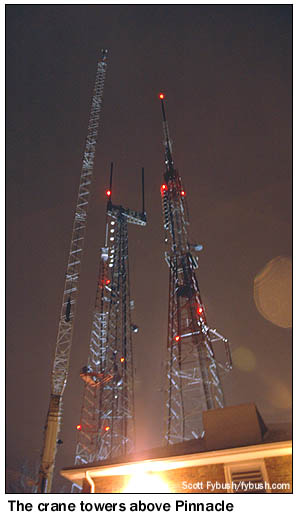
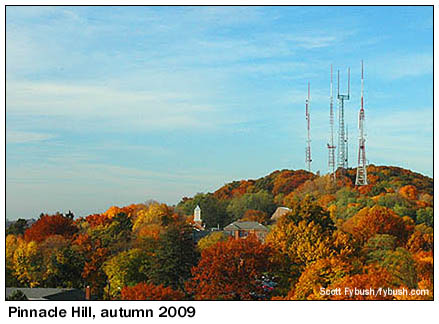
Welcome to a new year of Tower Site of the Week - and to the fourth time we've visited Rochester's Pinnacle Hill, a site that's close to your editor's heart, not to mention less than a mile from his home.
In previous installments, we've taken you through the transmitter buildings that are home to five full-power TV stations, three class B FMs, a class A FM and a slew of low-power TV and FM translator signals (see parts 1 and 2 of that 2007 edition here and here), watched the analog TV signals on the hill go dark in 2009 (here) and then caught up on some of the changes on the hill later in 2009 and into 2010, here.
But when we last visited the hill in this column, there was still at least one big change yet to come: the image of Pinnacle hill seen above at left, and on the October page of your new 2011 Tower Site Calendar, was due for a big alteration: the analog antennas for WXXI-TV (Channel 21) and WUHF-TV (Channel 31), mounted for three decades atop the "goalpost" tower at the middle of the hill, were due to come down.
It finally happened early on the morning of December 5, 2010, and we were there for much of the overnight work - and happy to share our photos with Site of the Week readers!
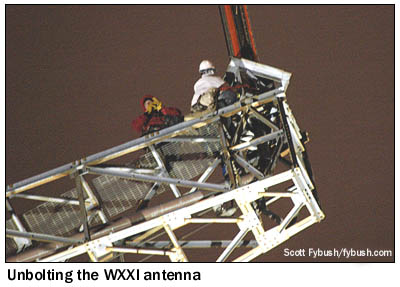
|
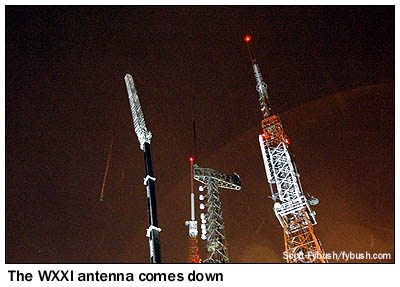
|
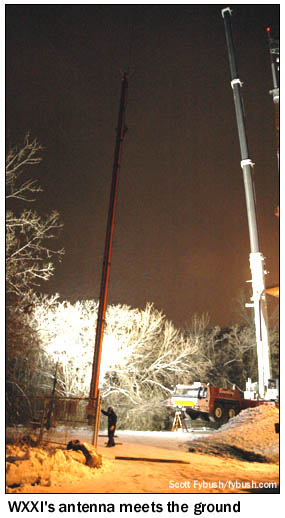 Doing
any kind of heavy work on the Pinnacle Hill towers generally
has to be an overnight affair; with four full-power DTV stations
transmitting from antennas located within just a few dozen feet
of each other, tower crews can't be atop one station's tower
without the others powering down.
Doing
any kind of heavy work on the Pinnacle Hill towers generally
has to be an overnight affair; with four full-power DTV stations
transmitting from antennas located within just a few dozen feet
of each other, tower crews can't be atop one station's tower
without the others powering down.
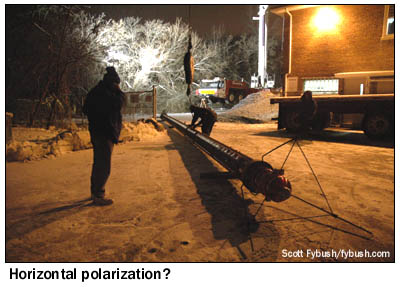 When
can that happen with minimal disruption to TV ratings and pledge
drives? Two in the morning on a Sunday...a cold, windy, snowy
one, as it turns out.
When
can that happen with minimal disruption to TV ratings and pledge
drives? Two in the morning on a Sunday...a cold, windy, snowy
one, as it turns out.
So it's with great admiration (and even greater relief that it's not us up there climbing the things), we settle in to watch the crews from Fred Nudd's construction company begin dismantling the very tower they erected back in 1979. Nudd himself, still spry at 93, is on the scene when we pull up, guiding a crew that includes his grandson.
A few days before the shutdown, work began on assembling the massive crane that will rise 400 feet into the sky to bring the TV antennas (each of them about 70 feet tall) down to earth, and the first few hours of work tonight find one group of Nudd's climbers ascending the tower to get into place for the antennas' removal while another, smaller group sets about slowly raising the crane until it's as tall as the towers here, which are dramatically lit from generator-driven lights down at ground level.
The first antenna to come down is the one that was used by WXXI-TV on channel 21 until the end of analog TV here. It was down from the tower once before, when a lightning hit a decade or so ago forced it to be rebuilt, so the crews figure it might be somewhat easier to unbolt than the WUHF (Channel 31) antenna, which hasn't budged from its place since it was installed here just prior to WUHF's debut in January 1980.
As it turns out, the WXXI antenna doesn't come off without a fight (and help from a portable air compressor lifted up to the crossbar atop the tower by the crane!) It's about 3 AM by the time the WXXI antenna finally comes loose, held up by a hook (attached by a tower climber who's climbed up the antenna itself to grab the hook from the crane) and gently - not to mention very carefully - lowered to earth alongside the fence that surrounds the transmitter buildings.
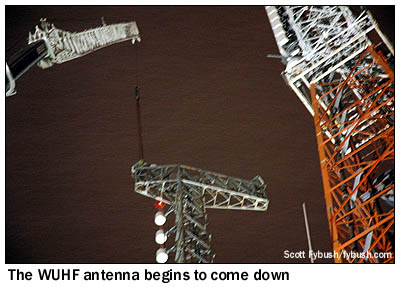
|
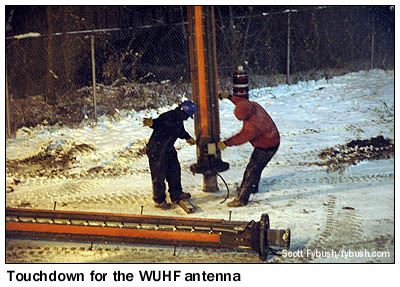
|
The ground crew immediately sets to work on the antenna, inspecting the lightning damage it had suffered (some of the orange plastic radome material covering the antenna's slots is scorched and twisted), removing the top beacon (it will be returned to the top of the tower) and beginning the laborious process of cutting up the antenna so it can be loaded atop a waiting flatbed trailer and hauled off for scrap in the morning. Meanwhile up on the tower, the climbers have hooked the remaining antenna to the crane and begun loosening its bolts.
It's 4 AM by the time the WUHF antenna begins its stately swing down to the ground, and for the first time since the tower was built, it's devoid of antennas up top - and the two UHF TV antennas are, very briefly, united in a line at ground level.
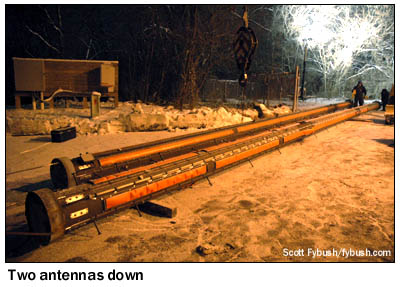
|
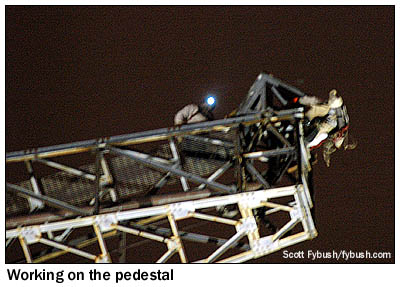
|
Even on a Sunday morning, the commercial stations are eager to get back on the air before dawn, so it's becoming clear at this point that the dismantling of the tower's top will have to be a multiple-night affair; the pedestals that supported the antennas and the big steel crossbar will come down another night, though there's at least a brief attempt to get the pedestals removed before the climbers have to come down and the stations sign back on.
We drive away from Pinnacle Hill (and to a hot shower and some much-needed sleep) with an odd sight to greet us: no antennas atop that crossbar, leaving an odd-looking "T." High winds and heavy snow prevent the rest of the work from taking place right away - indeed, an attempt the next day to get a wide shot of the newly-shorn tower is thwarted by blowing snow that makes it impossible to see the towers at all! The crews finally do get up there a few nights later, removing the crossbar in several pieces. (It was designed to come apart from the beginning, as it turns out.)
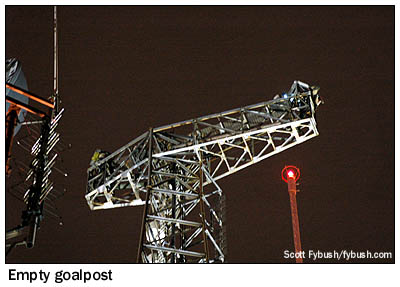
|
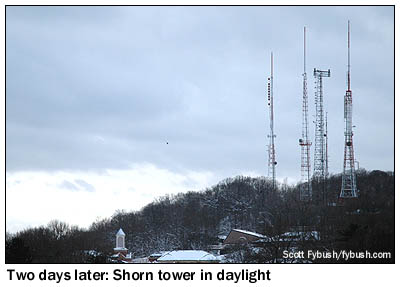
|
So why go to all this work in the middle of the winter, just to leave a bare-looking tower top with all of the remaining services on the tower (WXXI-FM 91.5, WXXI-TV's digital signal on channel 16, WRUR-FM 88.5 and several translators) side-mounted below?
By removing the analog antennas and the crossbar, the tower could then support the considerable windload of a new FM antenna: a seven-around, one-bay ERI panel antenna that will enable a considerable power increase for WRUR, the signal owned by the University of Rochester and operated under a long-term contract by WXXI.
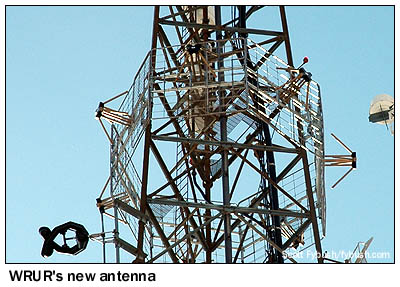
|
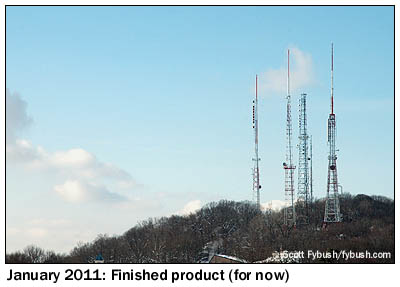
|
That antenna began to go up in early January 2011, just after the FCC granted a construction permit for the WRUR upgrade, and we show it above as it appears (literally) today, almost ready for more power.
Eventually, the side-mounted digital TV antenna will be replaced by a new top-mounted antenna, boosting WXXI-TV's coverage as well - and when it is, it's a pretty good bet we'll be up here again, sharing that with you, too!
 - Find out when the new Tower Site is posted,
and much more! Follow us on Twitter @NERadioWatch - and don't miss your chance to order the all-new
Tower Site Calendar 2011, featuring the autumn 2009 Pinnacle
Hill "before" image shown above, at the Fybush.com store!
- Find out when the new Tower Site is posted,
and much more! Follow us on Twitter @NERadioWatch - and don't miss your chance to order the all-new
Tower Site Calendar 2011, featuring the autumn 2009 Pinnacle
Hill "before" image shown above, at the Fybush.com store!- Previous Site of the Week: WCTM, Eaton, OH
- Next Week: Madison, Wisconsin, 2009
- Site of the Week INDEX!
- How can you help support Site of the Week? Click here!
- Submit your suggestions for a future Site of the Week!

